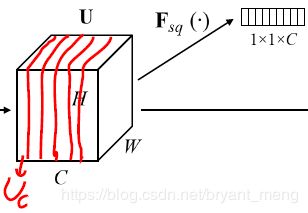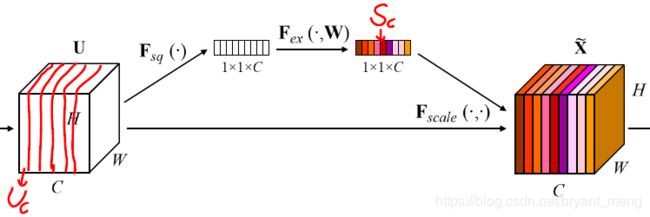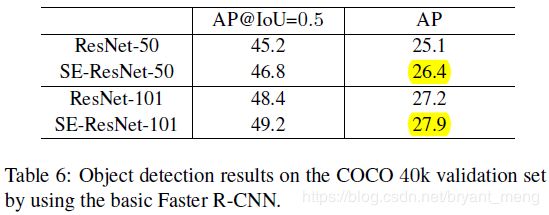【SENet】《Squeeze-and-Excitation Networks》
caffe 代码:https://github.com/hujie-frank/SENet
caffe 代码可视化工具:http://ethereon.github.io/netscope/#/editor
文章目录
- 1 Background and Motivation
- 2 Advantages
- 3 Related work
- 4 Method
- 4.1 Squeeze: Global Information Embedding
- 4.2 Excitation: Adaptive Recalibration
- 4.3 Exemplars: SEInception and SEResNet
- 4.4 Model and Computational Complexity
- 5 Experiments
- 5.1 ImageNet Classification
- 5.2 Scene Classification
- 5.3 Object Detection on COCO
- 5.4 Analysis and Interpretation
- 小节
1 Background and Motivation
CNN extract informative features by fusing spatial and channel-wise information together within local receptive fields.
为了 增强 CNN 的 representation power
- several methods:enhancing spatial encoding(spatial correlations、spatial attention)比如,inception 中的多个感受野 concatenate
- 作者:focus on the channel relationship
因此作者设计出 Squeeze-and-Excitation 结构,emphasise informative features and suppress less useful ones(channel-wise)
2 Advantages
- ILSVRC2017 classification first place
- reduced the top-5 error to 2.251%
The development of new CNN architectures is a challenging engineering task, typically involving the selection of many new hyperparameters and layer configurations.
3 Related work
-
Deep architecture
-
Attention and gating mechanisms
4 Method
the role it performs at different depths adapts to the needs of the network
- In the early layers, it learns to excite informative features in a class agnostic manner
- In later layers, the SE block becomes increasingly specialised(in a highly class-specific manner)
SE 结构可以自成一派(用 SE block stacking 成 neural network),也可以中西结合,即插即用,as a drop-in replacement for the original block at any depth in the architecture(eg,resnet、resnext 的 bottleneck block).

F t r F_{tr} Ftr is a convolution operator , F t r : X → U F_{tr}:X→U Ftr:X→U,具体运算如下

对于上面公式的理解,可以参考如下图片

X X X 即为输入的 feature map, V c V_c Vc (上图红色字体,小写c,黑色的为大写)为某个 filter, u c u_c uc (上图红色字体,小写c,黑色的为大写)是某个生成的结果!
其中 V = [ v 1 , v 2 , . . . , v C ] V = [v_1,v_2,...,v_C] V=[v1,v2,...,vC](大写的 C)
其中 U = [ u 1 , u 2 , . . . , u C ] U = [u_1,u_2,...,u_C] U=[u1,u2,...,uC](大写的 C)
![]()
![]()
上标表示 spatial kernel,也即我图片中拆分出 X X X 和 v c v_c vc(小写的 c )画出来的部分!这样就明朗了很多,至于从这个耳熟能详的公式,如何就能引发对 channels 的特征重要性的思考,进而提出 SE block 的结构,我目前还体会不出来!
4.1 Squeeze: Global Information Embedding


u c u_c uc 是特征图 u u u 的 c c c 通道,上面的公式是对该通道进行 global average pooling, z c z_c zc 为标量,是 channel descriptor(如下图) 的一小格
![]()
当然,global average pooling 只是一种统计全局信息的方式,more sophisticated aggregation strategies could be employed here as well.
4.2 Excitation: Adaptive Recalibration
两个设计准则
- flexible(channels 之间有 non-linear interaction)
- non-mutually-exclusive(非互斥的,避免 one-hot)
作者落地的方式为:employ a simple gating mechanism with a sigmoid activation,再细化一点即 two fully connection,再具体一点,如下图所示,第一个 fc 降低 dimension,activation function 为 relu,第二个还原为原来的 dimension,activation function 为 sigmoid(借鉴 LSTM 中的门机制)

公式如下:
![]()
δ \delta δ 为 relu, σ \sigma σ 为 sigmoid
![]()
上述公式的意义为, U U U 的一个 channels 与 s s s 的一个 dimension 相乘,相当于对 feature map 的加权!对应如下图 F s c a l e F_{scale} Fscale 部分!

最后的输出
![]()
总结一下
- F s q F_{sq} Fsq global average pooling
- F e x F_{ex} Fex two fully connection
- F s c a l e F_{scale} Fscale feature map ( U U U) multiply channels weight ( F e x F_{ex} Fex 的输出结果)
4.3 Exemplars: SEInception and SEResNet
- SEInception:
F t r F_{tr} Ftr 替换成 Inception block,关于 Inception 的理论与实践,可以参考 https://blog.csdn.net/bryant_meng/article/details/78597190 中1.1 Classification / Object Detection和4.1 【Keras】Classification in CIFAR-10 系列连载

左边正常的 inception,右边 SE-Inception
4.4 Model and Computational Complexity
trade-off between model complexity and performance
| ResNet-50 | SE-ResNet-50 | |
|---|---|---|
| GPU:training a mini-batch 256 images,8 TItan X | 190 ms | 209 ms |
| CPU:inference | 164 ms | 167ms |
global pooling and inner product are less optimised in existing GPU libraries
额外的参数量如下:two FC layers of the gating mechanism

- s 为 stage
- r 为 reduction ratio
- N s N_s Ns 为 repeated block number for stage s.
- C s C_s Cs 为 the dimension of the output channels,也即 number of channels

看这个图就知道怎么计算了 ,某个 stage 中的一个 block 的计算量增加量为 C r ∗ C + C r ∗ C \frac{C}{r}*C+\frac{C}{r}*C rC∗C+rC∗C,我们都知道,越后面的 stage,C 越大,增加的计算量也越大,作者实验表明,去掉后面 stage 的 SE 结构,效果不会降太多,但是计算量会增加的少一些!
5 Experiments
database
- ImageNet 2012
- COCO
- Places 365-Challenge
r r r :reduction ratio is 16
5.1 ImageNet Classification

看 SENet 的小括号,加 SE 结构效果都有提升!看看下面训练和测试的 loss

看看在轻量级网络上的表现

看 table 2 和 table 3 SENet 小括号中的内容就说明了一起,强,有普适性, can be used in combination with a wide range of architectures.(residual or no residual)
5.2 Scene Classification

providing evidence that SE blocks can perform well on different datasets
5.3 Object Detection on COCO
5.4 Analysis and Interpretation
1)Reduction ratio
r r r :作者设置 reduction ratio 为 16,trade-off between model complexity and performance

2)The role of Excitation
感觉是统计 SE block 在 squeeze 之后,excitation之前的 activation 情况,5 类,每类 50 个样本,average activations for fifty uniformly sampled channels
作者有如下三个发现:
- lower layer features are typically more general(例如(a),说明特征共享)
- higher layer features have greater specificity(例如(c)、(d),不同类别的不同 channels激活值不一样)
- (e)中,activation 为1,也即类似于 identity 了, 所以在此处加不加 SE block 不是那么重要,不加的话还可以大量减少计算量,参考本博客 4.4 小节的分析!
小节
利用了 gate mechanism,有普适性,图 5 的关于特征的分析尤为重要,以及 reduction ratio(two fully connection 中)complexity 和 performance 的 trade off!





